by Hagerty.com
We completely understand. No Time to Die hasn’t hit theaters yet and, despite our sharp-eyed take on the trailer, it’s a genuine struggle to endure the dreariness of March without readily-available Aston Martins. Pour yourself a mug of something warm and worry no more.
It’s been 70 years since Aston Martin first called anything “Vantage,” and the blokes over at Gaydon have had a blast slapping the name on all sorts of fabulous cars since. We decided to break down Vantage history, generation-by-generation, in all its many flavors. Take advantage of it, eh ol’ chap? (Sorry for that, we’ll get right to it.)
1950 Aston Martin DB2, Vantage “spec”

When it comes to vintage Astons, you’re probably conjuring up the beautiful, Bond-famous DB5. Though the Vantage name would, eventually, define a distinct model, it started out as an engine specification on the 1950 DB2. The DB2 may seem hokey next to those ’60s cars, with a grille almost as tall as it is wide and a set of round, chrome-rimmed headlights perched on the very tip of each fender.
This Aston held its Vantage cards close to its chest. Indeed, you won’t be able to visually distinguish a standard DB2 from one toting the Vantage-spec engine. If you popped the hood and were fluent in Lagonda straight-six, larger carburetors were one indication. The 2.6-liter engine boasted a higher 8.16:1 compression ratio in Vantage-spec and made—here we quote Aston Martin—a “heady” 125 horsepower. When in the ’50s or right now, we’d certainly never turn our nose up at the chance to wind out this piece of English finery.
1961 Aston Martin DB4 Vantage
The first aesthetically distinct Vantage rolled in as a sub-model in the DB4 Series IV line as of 1961. Have a gander at the headlights, if you’re unsure which Series IV sits before you; the Vantage models borrowed the closed headlights from the DB4 GT (essentially a homologation special, and later rebodied by Zagato in an ultra-exclusive run).
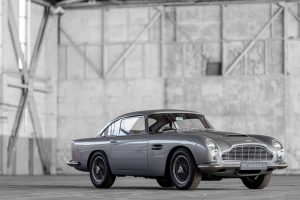
All DB4s started with a 3.7-liter, aluminum-block straight-six designed by Tadek Marek that put out 244 horses, but to make the 266-hp Vantages, Aston slapped on an additional carburetor, for a total of three, and spent some time on the cylinder heads, equipping them with larger values and in turn upping the compression ratio. (This hotted-up engine Aston marketed as the “Special Series engine.”) A total of six Vantages got the 4.2-liter, 345-hp version of this engine from the homologation-special DB4 GT. Yes, please.
“There are a lot of collectible, special DB4s,” says Hagerty auction editor Andrew Newton. “The DB4 GT and DB4 GT Zagato are at the top, being race-oriented cars with lots of power and Weber carbs—in the DB4 hierarchy, the Vantage version isn’t quite as special.”
A DB4 Vantage was the first Aston with a James Bond connection—albeit a tenuous one. The Goldfinger gadget car, which sold for $6.38M this past August, started life as a late-model DB4 before being built out into machine-gun spec. Lest you be alarmed that the Goldfinger car you know as a DB5 actually is a DB4, Aston Martin says the gadget car was “effectively a prototype DB5.”
1964–66 Aston Martin DB5 Vantage
Breathe easy, we’re officially in DB5 land.
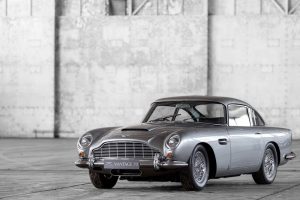
The standard DB5 and the Vantage model varied not by number of carburetors, as in the DB4 model line, but by the brand. The 288-hp DB5 got triple SU units, and the Vantage got triple Webers for a grand total of 325 hp. In addition to their James Bond allure, the DB5 benefits from exotically low production numbers. Rarest among the production DB5s (here we exclude the unique movie car variants) is the DB5 Vantage convertible, with only eight units produced; but only 68 DB5s out of the 887 hardtop run received the Vantage treatment. Cue the jazz hands—and one besotted collector market. (We say that with all sympathy. Just look at the thing!)
“Most DB5s in #1 (Concours) or #2 (Good) condition are worth close to or past a million dollars,” says Newton, “but with their extra performance and extreme rarity (just seven DB5 Vantage convertibles, for one), Vantages are worth significantly more.”
1965–1970 Aston Martin DB6 Vantage
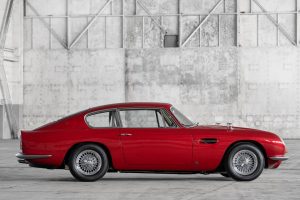
It’s far easier to list what the DB6 Vantage did not share with the DB5 Vantage than what it carried over. The coachwork got slightly tweaked, with the DB6’s roofline extended slightly rearward and flowing into a tucked-up Kammback rear end. Though the DB6 also got a more prominent B-pillar, the rear view will be your most obvious differentiator; in addition to the lip running across the trunk and framing the taillights, the DB6’s lights were integrated into a single unit, rather than the DB5’s individually stacked units. The side strakes still, helpfully, wore Vantage script, and under the hood for both Mk I and Mk II versions lay six straight cylinders of Weber-equipped goodness making the same 325 horses.
1967–71 Aston Martin DBS Vantage and 1972–79 Aston Martin AM Vantage
Had the new V-8 been ready in time, the DBS Vantage that bowed in 1967 would have been ludicrously new. Carrying the same Tadek Marek six, in either standard or Vantage form, the rebodied DBS was only obviously new. The new body was penned by William “Bill” Towns (at the time, an interior designer, but destined to draft the Lagonda a few years later), and featured a dramatically tapered tail with vertically oriented taillights. Sharp fender creases led into a squared-off front fascia with lights integrated into a much-slimmer, far-wider grille.
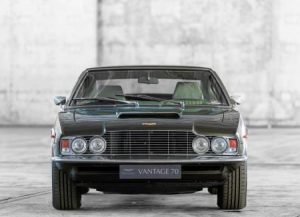
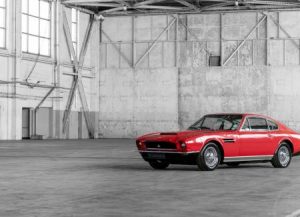
You can differentiate between the earlier DBS Vantage and the later AM Vantage by counting the headlights; the later AM Vantage, introduced in April 1972, got four. Aston admits the AM Vantage was the “least potent” offering at the time; even with revised camshafts in that straight-six, all that new metal must have added up.
1977–90 Aston Martin V8 Vantage
All hail the first V-8 Vantage. Yes, it did share that fabulous new 5.3-liter V-8 with the polarizing Lagonda sedan—but never fear, the Vantage version of the mysteriously named Aston Martin V8 got special treatment. High-performance camshafts, larger inlet valves, and larger 48 IDF carburetors paired with revised intake manifolds gave the V8 Vantage 80 more horsepower over the standard V8 model. Naturally, Aston also showed the Vantage suspension some love, adding a larger anti-roll bar, adjustable Koni dampers, and shorter springs.
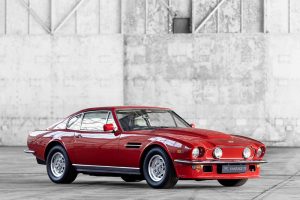
The V8 Vantage enjoyed a particularly long life, and along the way spawned a similarly-named, Zagato-bodied run (in the tradition of Zagato-bodied DB4 GTs back in the ’60s). Scroll down this list and stop at the first red car that isn’t the size of a chickpea. That’s an 1986 Aston Martin V8 Vantage Zagato—in particular, one owned by Rowan Atkinson. It doesn’t look anything like the British-born-and-raised V8 Vantage and sadly didn’t fare so well at auction this past summer. From that V8 Vantage derivative came yet another Zagato derivative, the Autech Stelvio. (We spotted one of these deliciously strange rides this summer cruising around Detroit.)
1993–2000 Aston Martin Vantage
This mid-’90s Vantage falls in a swarm of nomenclature changes. Its place in the hierarchy, as a higher-performance sub-model, was the same as many of its predecessors. However, the “standard” model on which this Vantage was based swapped nameplates from the Virage to the V8 Coupe (and back again, several years later).
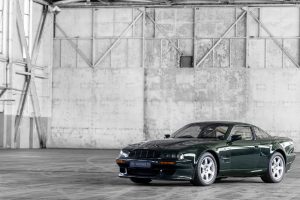
Often identified specifically as the “V550” Vantage to avoid confusion—with mixed success, we’d argue—this was the first forced-induction Vantage. Two Eaton superchargers got bolted onto that 5.3-liter V-8 engine and boosted output to 550 horsepower (hence the V550 name). Later on, in 1988, Aston Martin Works got its hands on a few Vantages and worked its magic to get 600 horses out of the powerplant. You guessed it, that was the V600.
“While certainly no lightweight at over two tons, the twin-supercharged Vantage belted out 550 horsepower (and 555 lb-ft of torque) at a time when Lamborghinis, Vipers and 911 Turbos made do with well under 500. The Aston even had the 515-hp Ferrari F50 beat, but period road testers called the Vantage unpredictable and scary to drive,” says Newton. “Despite its massive output it was far from the gold standard for GT cars.”
1999–2004 Aston Martin DB7 V12 Vantage
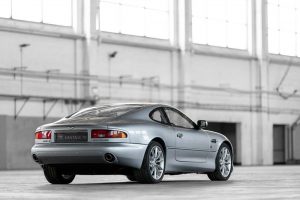
Unveiled in 1999, the DB7-based Vantage was the first to use a different power plant than the standard model. Boasting twice the cylinder count of its little brother, the Cosworth-built 5.3-liter V-12 in this Vantage gave owners the bragging rights to 420 horsepower and a top speed of 184 mph when paired with the automatic transmission. Again unlike other Vantages, the V-12 model racked up a relatively high production run—2091 cars in four and a half years.
2005–2017 Aston Martin V8 Vantage
This wide-hipped model proved the highest-selling of all the Vantages to date, with well over half of the cars delivered someone outside the U.K. Riding on the DB9’s long-lived VH architecture, the 2005 car benefited from that uncommon phenomenon in the Vantage line: a new engine. The V-8 under the hood of this Vantage was a naturally aspirated, 4.3-liter dry-sump affair with four cams and an output of 380 hp.
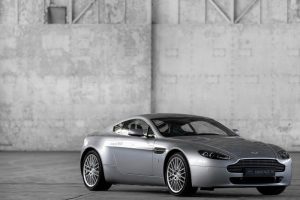
Further on, power went up to 420 hp, thanks to 4.7 liters of displacement, and in 2009 it was kept company by a 5935-cc 12-cylinder powerplant making 510 hp. Aston continued to roll out the updates to this model, introducing the 565-hp V-12 S Vantage in 2013, which broke the 200-mph barrier for an Aston Martin production car. Zagato got involved with this Vantage, as well, naturally selecting for its bespoke efforts the V-12 model. Hey, no complaints from this side of the pond.
2020 Aston Martin Vantage
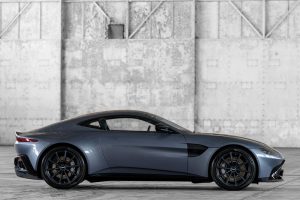
The current Vantage, which just recently shed its top, is back to an eight-cylinder noisemaker up front, displacing 4.0 liters and, like its late ’90s sibling, using forced induction. Two turbochargers hike power to 503 hp and deliver a potent 0–60 time of 3.5 seconds. In our recent test drive, we found it to be a highly entertaining and capable GT car with a refreshing flavor.
